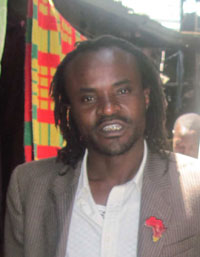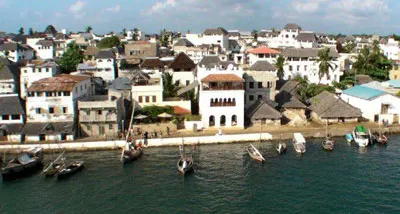Freelance photographer Abdalla Bargash had accompanied Kenya’s permanent secretary for transport, Cyrus Njiru, to cover a meeting with Lamu community members over the newly constructed Lamu port. The Kililana Farmers’ Association are concerned that the major construction on the once-sleepy island of Lamu off Kenya’s coast could encroach on their farmland.
The leaders of Kenya, South Sudan, and Ethiopia this month officially launched the Lamu port project, which is expected to become the gateway to Africa’s Great Lakes and Horn regions. It will include a highway connecting Kenya to Ethiopia and an oil pipeline connecting South Sudan to Lamu. The multibillion dollar project “includes railways, road networks, airports, pipelines, and refineries as well as tourist resorts,” Kenyan Prime Minister Raila Odinga said at the launch.
Many Lamu residents, however, are wary. “People in Lamu are crying,” said freelance filmmaker Omar Athman, who covered some of the protests held by residents. “They complain that they have not been consulted about this project and will not benefit in any way.” No environmental consultation on the impact of the port has been undertaken, according to Save Lamu, an umbrella group of community organizations that oppose the project.
“During the rainy season, fishermen rely on shallow waters around here,” Bargash told me. “Who knows how they’ll manage when the area becomes filled with tankers?” But Bargash believes that while some residents’ livelihoods will be hurt, others will benefit. “An old woman I met selling snacks in the market, for instance, used to sell around 10-20 chapatis per day. Now she sells around 200,” he said.
Covering the viewpoints of those who do not support the Lamu project, however, can be challenging. When Bargash tried to take photos of the meeting between the transport official and the Kililiana Farmer’s Association, officials confiscated his memory card and notebook and Njiru refused to provide Bargash a lift home, forcing him to trek two hours by foot.
“They wanted to take my camera as well but I refused. They took my memory card but I managed to switch cards and gave them a blank one,” Bargash told me with a laugh. Bargash says the incident was a minor one and did not bother him much. But it’s indicative of the challenges African journalists face trying to cover major development projects, in a region where many governments expect journalists to report positively on development projects. “Criticism of the government is considered ‘unpatriotic’ and ‘disloyal’,” said veteran Zimbabwean journalist Bill Saidi.
Many journalists in eastern Africa have faced the wrath of authorities for their criticism of government development projects. Ethiopia’s High Court convicted columnist Reeyot Alemu in January on anti-terrorism charges for her alleged involvement in an unsubstantiated plot to destroy electrical and telecommunications infrastructure. Many local journalists, however, suspect Reeyot was targeted for her critical columns over the government handling of a major Ethiopian dam project, the Grand Millennium Dam.

In the early 2000s, journalist and activist Argwings Odera nearly lost his life for his critical coverage of another dam project in western Kenya. A local resident himself, Odera saw many faults in the Sondu Miriu Dam project that the mainstream media had missed. “The project at that stage was a white elephant, and the locals were going to get stuck with the environmental consequences,” Odera told me. “They wanted to divert the river for a 17-kilometer stretch, but members of the community depended on this water. The mainstream media only covered the proposed benefits without looking at the less rosy picture on the ground.” Eventually, Odera’s reports of mismanaged funds caught the ear of donors such as the Japanese government, and outside funding was withheld.
Eventually the Sondu Miriu Dam was built with the local community’s considerations taken into account, but at great expense to Odera. Soon after donors cut their funding, an irate then-President Daniel Arap Moi called Odera a traitor on state television, Odera said. Police arrested Odera three times, tortured him under custody and even shot him in the shoulder, he told me. The police, who admitted in court that they had shot Odera, claimed they were “following orders.” Odera was forced to flee the country.
Media coverage of the Lamu Port project has similarly remained upbeat, says George Nyabuga, journalism and media lecturer at the University of Nairobi. “With exception to an article written by the critical magazine Nairobi Law Monthly that accused Lamu Port project authorities of mishandling funds, Kenya’s media has generally portrayed the project as largely positive,” he said. Nyabuga does not believe the mainstream media have properly investigated — partly due to compromised interests. “The big media houses do not want to lose advertising revenue — few can pass up a two-page advert about the port.” Many media owners also maintain close relations with the political figures involved, and refrain from releasing critical reviews, he said. “Maybe the less-known citizen journalists, the bloggers, etc. are more likely to report critically on these development projects,” Nyabuga suggested.
But “local journalists covering state development projects are in a no-win situation,” Odera told me. “You are easily intimidated, compromised by those working on the project — since you have little protection or means to defend your views.” Clearly, local Lamu journalists such as Abdulla Bargash must remain vigilant if they plan to cover further protests by residents — and CPJ must keep a keen eye to look out for them.
